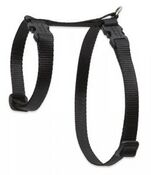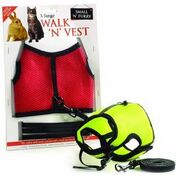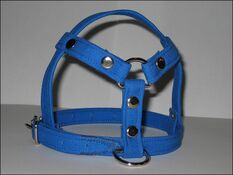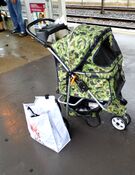Walking a rabbit
If you would like to take your rabbit outdoors in an unenclosed rabbit-safe area to explore, it is important to accustom your rabbit to a harness and lead to prevent them running off.
Be mindful of the usual outdoor dangers including parasites and disease if you choose to take your rabbits outside.
Many rabbits prefer not to leave familiar territory and will be very nervous when taken to new places.
What are the dangers of leashing your rabbit?
Understand that not all rabbits can be easily acclimated to a harness and leash, and for these rabbits, it is best to only let them outside in enclosed areas instead of using a leash and harness. Rabbits can break bones and seriously injure themselves in a panic while leashed.
How do I choose a harness for my rabbit?
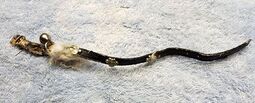
February 17, 2017: Update.
February 24, 2017: Final update, after 4 weeks of treatment Buttons is doing great and was adopted by a vet nurses, Stacey and her family at RRBH.
There are several types of harnesses available for purchase that a rabbit can use. Rabbit agility sites provide helpful resources for recommendations.
Regardless of the type chosen, harnesses should be properly fitted and snug on a rabbit when used. The harness should only allow one or two human fingers in between the rabbit's collar or waist. If it is too tight, the rabbit will be uncomfortable and may become stressed.[1] If it is too loose, the rabbit may be able to chew or slip out of the harness. Do remember that a rabbit has a lot of fur, so although it may look tight on the rabbit, it is mostly fluff.
No matter how cute a harness is, if it does not fit the rabbit, it is not safe to use. Do not leave rabbits unattended with a harness and lead on. Safety first. See Riverton Rossmoyne Veterinary Hospital's story of a stray rabbit found with a collar stuck around his teeth and jaw (additional graphic before and after image series).
H-harness
H-harnesses are the most popular type of harness for rabbits. These can easily be obtained at a pet store in the kitten, cat, or dog sections.
Some examples on Amazon:
- Rogz Catz Alley Small 3/8-Inch Cat Reflective Lead and Adjustable Harness Combination
- Lupine 1/2" Black H-Style Pet Harness
An H-harness looks like a sideways H when laid out on a table. There should be two buckles -- one around the neck and one around the waist. These can easily be adjusted to properly fit a rabbit.
Some H-harnesses, especially cat ones, may also come with a chest strap. It is recommended to cut the chest strap off because it rarely fits well on a rabbit. Additionally, the chest strap may restrict a rabbit's movement when stretching to hop. Some have found that a belly strap on the harness makes it easier for the rabbit to escape out of the harness and puts the neck strap within reach of the rabbit to chew on.[2]
Connect the lead to the waist loop, not the neck loop. This harness style is safe because each section is separately adjusted, and a rabbit will have pressure distributed across the belly in the case of pulling instead of the neck like a collar.
Vest or coat harness
These types of harness are usually specially targeted for small animals like rabbits and ferrets. This harness will have a ring at the top to clip a lead on.
Some examples on Amazon:
- Peter's Rabbit Walking Jacket, Blue
- Ware Nylon Walk-N-Vest Small Pet Harness and Leash, Large
- Trixie Soft Harness With Lead To Fit : Rabbits
- Super Pet Ferret Comfort Harness and Stretchy Leash
- Marshall Pet Products Rabbit Walking Jacket
Most vest and or coat type harnesses close with velcro fasteners at the neck and the waist. Two layers of velcro is best. Keep the velcro clean for maximum security. Some are made with buttons or snaps. Check buttons often, and remember how a button can pop off a shirt. If snaps become loose, discard this type of harness.[3]
Shoulder harness
Shoulder harnesses are popular in the rabbit agility community. However, these will not be found in the regular pet store and must be custom ordered. One strap of the shoulder harness goes around the chest, and another goes around the belly.
The thought behind this model is to put the pressure of a rabbit's weight across the shoulder instead of the throat. Because of the minimal strangling sensation of the shoulder harness compared to the H-harness, rabbits that pull will tend to like a shoulder harness better.[4]
What harnesses are completely unsafe for rabbits?
There are options out there that are not safe for most rabbits to use listed below.
Figure 8 harness
A figure 8 harness is shaped as it is named and made out of one piece of fabric. The 8 makes openings with one fitting over a rabbit's head and one over the rabbit's waist. It has a single buckle that buckles over the back of a rabbit. Because it is made out of one piece, if a rabbit panics and gets the harness caught on something, the harness can easily tighten like a noose.
Rope Harness
Rope harnesses are a figure 8 harness with a lead made in one piece. The design adjusts and buckles over the back of the rabbit. While this is one of the lighter harnesses that can be fitted for a rabbit, the inherent danger with a panicking rabbit as stated with the figure 8 harness makes it not an optimal option. Additionally, the thinner a harness is, the more it can hurt a rabbit if pulled at.[1]
How can I teach my rabbit to accept a harness?
Most rabbits will need to be trained to accept a harness if necessary. However, please consider whether or not harness-training your rabbit is overall beneficial to their well-being if they are showing stubborn refusal and dislike to the notion.
The following are some resources on how to train a rabbit to accept a harness:
- About-pet-rabbits.com, Tips on training your rabbit, from first steps to complex stunts. (search for Leash Training)
- Raising House Rabbits, Training Your Rabbit > Chapter 4: Harness Training
- Rabbit Agility, Training Articles (search for Leash Training)
See Training a rabbit for more tips on how to train a rabbit.
Can I use pet strollers for my rabbit(s)?
An enclosed pet stroller may be an option to taking a rabbit away from home, especially for travel if you have many large rabbits that may be difficult to carry by hand.
With a soft stroller, be mindful that your rabbit does not quickly chew their way out and escape. Additionally, be wary about uncontrolled dogs in public areas that may be extremely interested in your rabbit and will not be significantly hampered by a soft cloth material.
Further reading
- Cheryl Lock. (2017). Can You Leash Train a Rabbit?
- Bunniez. (2013). How To Train Your Bunny To Walk On A Leash
- bunnyhugga. (2010). Exercise harnesses for rabbits
See also
References
- ↑ 1.0 1.1 Rabbit Jumping UK. (2012). Harnesses. Retrieved 17 Feb 2017 from https://web.archive.org/web/20121230015008/http://www.rjuk.moonfruit.com/harnesses/4548178681
- ↑ iowahopping. (n.d.). The H-style Harness. Retrieved 17 Feb 2017 from https://sites.google.com/site/iowahopping/getting-started-hopping-1
- ↑ Rabbit Agility. (2006). About Harnesses. Retrieved 17 Feb 2017 from https://sites.google.com/site/iowahopping/getting-started-hopping-1
- ↑ Rabb-it. (n.d.). Choosing the right type of harness. Retrieved 17 Feb 2017 from http://www.rabb-it.se/eng/choosing-model.html


